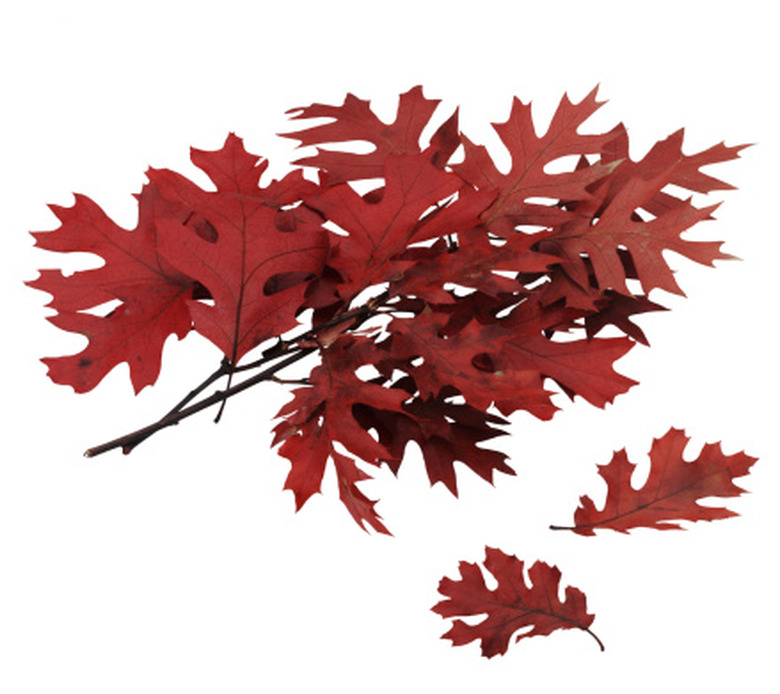How To Identify Different Types Of Oak Trees In North Carolina
You can distinguish oaks from other trees by the leaf buds that form in clusters at the end of twigs and their acorns. In the late spring, oak trees produce long strings of male flowers called catkins. Shortly thereafter, acorns begin developing. Although many people associate oak trees with their iconic lobed leaves, some of the oaks in North Carolina develop oblong leaf shapes without lobes. Duke University's website identifies 29 different oak species in North Carolina, 28 of which are natives. Distinguishing between the most common varieties requires primarily observing traits of the leaves, acorns and the tree's habitat.
Step 1
Describe the shape of the leaves. Narrow, tapering leaves without lobes belong to the willow oak (Quercus phellos). Leaves that begin narrow and widen to a broad, round tip, also lacking lobes, belong to the laurel oak (Q. hemisphaerica). Leaves with three sharp points at right angles from each other belong to the turkey oak (Q. laevis), named for the leaf's resemblance to a turkey foot.
- You can distinguish oaks from other trees by the leaf buds that form in clusters at the end of twigs and their acorns.
- Leaves with three sharp points at right angles from each other belong to the turkey oak (Q. laevis), named for the leaf's resemblance to a turkey foot.
Step 2
Note whether leaf lobes are rounded or pointed. Rounded lobes indicate that the tree belongs to the white oak group, while pointed lobes belong to the red oak group.
Step 3
Count the number of lobes on a leaf with rounded lobes and observe whether they are shallow or deep. Seven or more deep lobes indicate an eastern white oak (Q. alba), while fewer than seven indicate a post oak (Q. stellata) or overcup oak (Q. lyrata). To distinguish between the latter, find an acorn from the tree. The cap on overcup oak acorns almost completely covers the nut.
Step 4
Observe the tree's habit, if the leaf has rounded, shallow lobes. The swamp chestnut oak (Q. michauxii) inhabits wetlands, while you'll find the chestnut oak (Q. montana) on dry higher ground.
- Note whether leaf lobes are rounded or pointed.
- Seven or more deep lobes indicate an eastern white oak (Q. alba), while fewer than seven indicate a post oak (Q. stellata) or overcup oak (Q. lyrata).
Step 5
Feel the undersides of leaves with three pointy, shallow lobes. The water oak (Q. nigra) feels smooth on the undersides of the leaves, while the blackjack oak (Q. marilandica) and the southern red oak (Q. falcata) have fuzzy undersides. Leaf stems on the blackjack oak measure less than an inch in length, while stems on the southern red oak grow 1 to 2 inches.
Step 6
Rub the undersides of a leaf with five to 12 pointy lobes. Lobes may be deep or shallow. Eastern black oaks (Q. velutina) feel rough and fuzzy underneath, and the fuzz rubs off. The cherrybark (Q. pagoda) and southern red oak (Q. falcata) have fuzzy undersides, but the hairs do not come off. The northern red oak (Quercus rubra) feels smooth beneath, and lobes extend less than 2/3 to the midrib. Deeply lobed leaves with smooth undersides belong to the scarlet oak (Q. coccinea) and Shumard oak (Q. shumardii), with the former occupying dry upland forests and the latter found in moist lowland forests.
- Feel the undersides of leaves with three pointy, shallow lobes.
- The cherrybark (Q. pagoda) and southern red oak (Q. falcata) have fuzzy undersides, but the hairs do not come off.
References
- "Eastern Trees"; George A. Petrides and Janet Wehr; 1998
- Duke University: Trees, Shrubs, and Woody Vines of North Carolina
- Duke University: Summer Key to the Common Trees of Durham County, North Carolina
